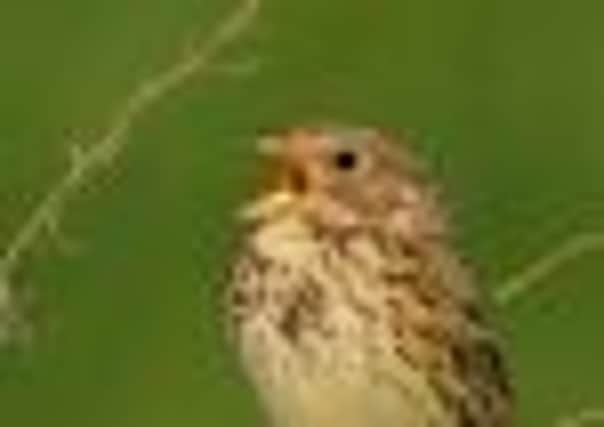Outdoors: Good will bunting


Usually it didn’t take too long to spot the songster – a corn bunting sitting on a fence post, a rather drab and nondescript little brown bird that barely merited a second glance as they were tolerably common at the time.
Fast forward 30 years or so, and the jingling of the corn bunting has fallen silent along the majority of these north eastern lanes. It is a story that has been repeated throughout Scotland, with the bird now extinct in many of its former strongholds with only small and dwindling populations still hanging on for survival in Inverness-shire, Moray, Aberdeenshire, Angus, Fife and parts of Benbecula and the Uists.
Advertisement
Hide AdThe most reliable estimate puts the Scottish population at only 800 singing males (they are the easier sex to census because of their distinctive call) and the fortunes of the bird would now appear to be slipping into oblivion. The corn bunting has been declining throughout the UK since at least the 1920s, but the scale of the population fall in recent times has been quite astonishing. Recent survey work in eastern Scotland conducted by the RSPB working in partnership with ecologist Dr Adam Watson has revealed a near cataclysmic 83 per cent decline between 1989 and 2007.
Unsurprisingly, such massive falls have caused considerable alarm among conservationists, although the good news is that the reasons for the freefall in numbers have been identified, with research pinpointing the intensification of farming practices in recent decades as the principal factor. Corn buntings are different from many other farmland songbirds in that they actually nest in the middle of fields on the ground late in the summer, whereas chaffinches, yellowhammers and similar species tend to breed in hedgerows and along field edges much earlier. This means that corn bunting nests are incredibly vulnerable to the early cutting of fields for silage in parts of their range. The problem has been compounded by the increased efficiency of herbicides, which in turn kills the weed food-plants of insects that are the main food for chicks. The switch from spring sown cereal crops to autumn sowing has also removed a key food source of seeds in stubble fields over the winter.
The key to the future survival of the corn bunting, according to Hywel Maggs of the RSPB, lies in the adoption of more friendly farming practices – and this can only be achieved if there are suitable agri-environment support schemes available that can compensate farmers for any subsequent loss in production. Unfortunately, reform of the Common Agricultural Policy is still underway and there is no clarity on when a final agreement will be reached. This means there is significant risk of a gap between current agri-environment provision and new long-term replacement support schemes. As a consequence, the RSPB is urgently looking for interim support from the Scottish Government as a stop-gap measure.
Certainly, where sympathetic farming techniques have been adopted, the population of the bird has increased, and there is no doubt that this is the key to the future. An RSPB scheme called Farmland Bird Lifeline has shown that on a selection of farms where corn bunting-friendly farming techniques were utilised and delivered with advisory support, the number of singing males increased by more than 5 per cent each year.
“We have found that many farmers enjoy knowing they have corn buntings on their land and recognise that they have important obligations as stewards of the landscape to protect biodiversity,” says Maggs. “This bodes well for the future, but farmers must have the financial support in order to meet such obligations.”
Maggs is in no doubt that the conservation of the corn bunting is vitally important to the overall health of our environment. “The corn bunting is a classic flagship species,” he states. “If we get it right for the corn bunting, then we will have got it right for a whole range of other insects, plants and birds found in our fields and hedgerows.”